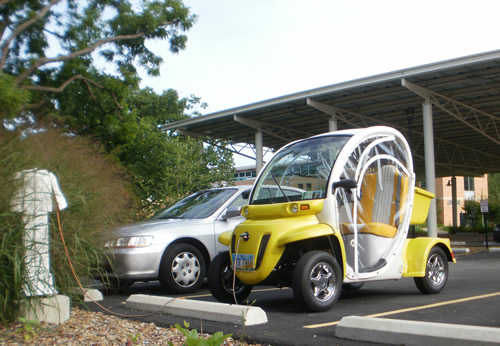Nearly-Perfect Oberlin Town Car.
It's street-legal, eye-catching, and goes 35 mph around Oberlin. Not quite a sports car, but sporty, for certain definitions of "sporty."

Here's my GEM recharging from the 101kW solar photovoltaic array (the large canopy in the background) at the Adam Joseph Lewis Center for Environmental Studies at Oberlin College. How green is that?
I should also mention the College's other, larger array being installed as I write in the fields north of my house. It's a 2.3MW, sun-tracking array that will help offset the College's electricity consumption. This is part of the College/City participation in the Clinton Climate Initiative, called "The Oberlin Project." Perhaps I'll buy a 1000' extension cord...
Want one? I'm selling them
What is it?
It's a Neighborhood Electric Vehicle, a special class of all-electric car limited in speed and highway use (no freeways or other fast roads). It has seat belts, safety glass, a windshield wiper, headlights, brake lights and turn signals, and rear view mirrors, so it meets the requirements for street use under this class. You can find them often in fleet use by security services, the Park Service, and other agencies. At times, tax credits were offered for purchasing these cars, but the rules change almost annually, so check into that if it matters to you. Credits almost always are for purchasing new vehicles, not used ones.
Who makes it? Is it American?
It was made in Fargo, North Dakota, in 2005 by Global Electric Motorcars, then a division of Chrysler. GEM has since been sold to Polaris, the ATV people, so we expect GEM will continue for some time to come. GEM started production in 1998, and there are about 45,000 on the road around the country (mostly in Florida, Arizona, and California, judging from eBay listings).
Why would you want one?
It's fun! It's open enough it feels positively breezy driving around town, and it certainly attracts attention. I can't believe I'm the first one in Oberlin to own one. To be truthful, this is the second electric NEV in town. Friends of ours have had a ZENN car for a couple years before I bought the GEM. Has Oberlin College heard of these? Sounds like just their thing. They do come in pickup styles, with miniature stake beds and cargo boxes, besides basic people transportation...
I've added soft, clear vinyl doors on the sides and rear window, so it's reasonably weather-tight now. The doors zip open and pin back for good weather traveling. Considering the short distances I'm driving this thing, the doors proved adequate in Ohio winters. Hard doors with sliding windows can be obtained from the factory, and as an aftermarket item, but they are expensive.The heater/defroster is also an option that this particular car did not have installed. I've found that a handheld hair dryer runs on the pack voltage (72vDC) and puts out enough hot air to keep the windshield clear for driving. I mounted that under the dash with ducting to direct the airflow onto the windshield. Cost me $4 for the hair dryer at Goodwill and nothing for the scrap piece of aluminum ducting. A heavy duty toggle switch was another $5. Cheap and effective. I paid about $6000 for this car, with 1300 mi on it; they go for upwards of $7500 new. This one has had a couple upgrades already, including a beefier motor for somewhat faster speeds. Hard factory doors add $2700 on top of that.
I should say the ride is a bit bumpy with the short wheelbase of only six feet. I'm told larger tires soften the ride a bit. The car is 52 inches wide, 99 inches long, and weighs about 1200 pounds. It has a 7.5 hp motor, and runs on six deep-discharge gel-cell lead-acid batteries. It came with 12 inch rims with 165/70 R12 automotive tires on them. Larger wheels would also increase the speed, but might require some modifications to make them fit.
It plugs into a standard 110v 15A outlet, and takes maybe 6-8 hours to fully recharge. I could drive it for 20 miles and then recharge it, but deeply discharging the batteries reduces their life, so GEM recommends recharging them every night. Overcharging gel cells can be a problem, so I typically run it down to about half capacity before I plug it in, about every 2 or 3 days. There is no memory effect with lead-acid batteries like there can be with nickle-cadmium cells.
Is it "environmentally friendly" and all that crap?
Sure! Let's look at the operating numbers. I'm assuming that I charge it at home, instead of off the photovoltaic array (better picture here) at the College, my municipal electricity costs $0.112 a kiloWatt-hour, and gasoline goes for $3.50 a gallon. Let's compare it with my minivan, the car this replaces...
The minivan actually gets 20 mpg. $3.50 divided by 20 shows a cost-per-mile of $0.175, seventeen-and-a-half cents per mile.
Let's say I drive the GEM 40 miles, and have measured just a hair over 10 kWh in recharging it during that time, a rate of 250 Wh per mile. I used a "Kill-a-watt" meter to make this determination. Seems accurate enough. The meter shows I've spent $1.16 recharging, which makes $0.029/mile, about six times cheaper than the minivan per mile. And insurance costs are lower, too.
But electric vehicles are merely "local emissions-free" - instead of polluting at the exhaust pipe, my pollution is at the power plant, which in Oberlin could be any number of things but is still all too often from a coal-fired plant. Oberlin's municipal utility partners with American Municipal Power, which together do better than average in using alternative sources, but let's use the national average figure for carbon dioxide produced from electricity generation to be fair.
Gasoline produces 19.643 lbs CO2/gallon consumed. The US average is 1.306 lbs CO2/kWh of electricity produced from a mix of sources. At 20 miles/gallon, my minivan produces 1 lb/mi CO2. To be fair, often the van was driven around with just a single passenger. Look around you on the highway to see how often this is the case.
Ten kWh times 1.306 lbs CO2 divided by 40 miles yields 0.25 kWh/mi or 0.33 lbs CO2 per mile driven in my GEM, one-third that of the minivan. Not perfect, but better. Here are some figures for comparison:
| Transportation mode | CO2 per passenger-mile |
|---|---|
| My Minivan | 0.98 lb |
| Airline travel, optimal | 0.88 lb |
| City bus | 0.66 lb |
| Amtrak (heavy rail) | 0.42 lb |
| Commuter light- rail or subway | 0.35 lb |
| My GEM | 0.33 lb |
| Long-distance bus | 0.18 lb |
(other transportation figures from Carbonfund.org)
To the extent that we use greener electricity sources here in the People's Republic of Oberlin, my GEM ought to be doing better than these figures suggest. But even so, it's the best four-wheel way of getting around town. (okay, but for this) -- and we don't have a rail system here in town any more.
As far as other pollutants go, it's far, far easier to clean up soot and hydrocarbon releases at the power plant stacks than on each and every tailpipe in America. Centralizing pollution controls helps keep the air cleaner, and electric vehicles are one way of moving the pollution problem to an easier location for removal. I should be riding my bike, but to the extent I use the GEM and keep the minivan off the roads, it's an improvement.
"Street-legal" - does that mean license plates?
I had to go to the Auto Title bureau in downtown Elyria to transfer the title, then to the BMV to register it. They gave me temporary plates at first, 'cause it hadn't passed the E-Check! I called the Ohio EPA office in Twinsburg, and explained the situation. I was given a permanent exemption from E-Check for this all-electric vehicle, and took that back to the BMV again, finally getting plates. Except for the E-Check, it registers just like a normal car.
How about insurance?
Unfortunately, my inusrance company, Nationwide, does not insure these vehicles. So after 30 years with them, both auto and homeowners policies, we're leaving Nationwide for State Farm, which does cover GEM cars. Too bad, but it's Nationwide's decision, really.
How did you find a used one?
I bought it on eBay from a nice couple here in northern Ohio, and towed it home on a U-Haul flatbed trailer. The gentleman had bought it in Texas, and has done extensive work making it as spiffy and shiny as you see in the photo above. After all that work, he wanted a 4-seat model instead!
At any given time, there are six to twelve GEM models on eBay, along with parts, manuals, and aftermarket modifications. Service is available from a nationwide service contractor, and your local mechanic won't find the suspension, steering, or brakes to be very different from typical cars they usually see. Many parts are stock versions for other vehicles or applications, although not all of those are automotive parts. Here are some places for more information:
NEV Service offers service and parts for your GEM
Ride-4-Fun sells doors, motors, and other useful add-ons

